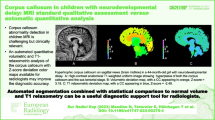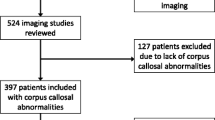Abstract
Thickening of the corpus callosum is an important feature of development, whereas thinning of the corpus callosum can be the result of a number of diseases that affect development or cause destruction of the corpus callosum. Corpus callosum thickness reflects the volume of the hemispheres and responds to changes through direct effects or through Wallerian degeneration. It is therefore not only important to evaluate the morphology of the corpus callosum for congenital anomalies but also to evaluate the thickness of specific components or the whole corpus callosum in association with other findings. The goal of this pictorial review is raise awareness that the thickness of the corpus callosum can be a useful feature of pathology in pediatric central nervous system disease and must be considered in the context of the stage of development of a child. Thinning of the corpus callosum can be primary or secondary, and generalized or focal. Primary thinning is caused by abnormal or failed myelination related to the hypomyelinating leukoencephalopathies, metabolic disorders affecting white matter, and microcephaly. Secondary thinning of the corpus callosum can be caused by diffuse injury such as hypoxic–ischemic encephalopathy, human immunodeficiency virus (HIV) encephalopathy, hydrocephalus, dysmyelinating conditions and demyelinating conditions. Focal disturbance of formation or focal injury also causes localized thinning, e.g., callosal dysgenesis, metabolic disorders with localized effects, hypoglycemia, white matter injury of prematurity, HIV-related atrophy, infarction and vasculitis, trauma and toxins. The corpus callosum might be too thick because of a primary disorder in which the corpus callosum finding is essential to diagnosis; abnormal thickening can also be secondary to inflammation, infection and trauma.



























Similar content being viewed by others
References
Ture U, Yasargil MG, Krisht AF (1996) The arteries of the corpus callosum: a microsurgical anatomic study. Neurosurgery 39:1075–1084, discussion 1084–1075. (Accessed 1 Nov 2013)
Georgy BA, Hesselink JR, Jernigan TL (1993) MR imaging of the corpus callosum. AJR Am J Roentgenol 160:949–955
Harnsberger HR, Osborn AG (eds) (2006) Diagnostic and Surgical Imaging Anatomy: Brain, Head and Neck, Spine. Int Ed ed: Amirsys
Weerakkody Y, Gaillard F. Corpus callosum. http://radiopaedia.org/articles/corpus-callosum. (Accessed Nov 2013)
Dougherty RF, Ben-Shachar M, Deutsch G et al (2005) Occipital-callosal pathways in children: validation and atlas development. Ann N Y Acad Sci 1064:98–112
Hasan KM, Kamali A, Iftikhar A et al (2009) Diffusion tensor tractography quantification of the human corpus callosum fiber pathways across the lifespan. Brain Res 1249:91–100
Hofer S, Frahm J (2006) Topography of the human corpus callosum revisited—comprehensive fiber tractography using diffusion tensor magnetic resonance imaging. Neuroimage 32:989–994
Park HJ, Kim JJ, Lee SK et al (2008) Corpus callosal connection mapping using cortical gray matter parcellation and DT-MRI. Hum Brain Mapp 29:503–516
Wilde EA, Chu Z, Bigler ED et al (2006) Diffusion tensor imaging in the corpus callosum in children after moderate to severe traumatic brain injury. J Neurotrauma 23:1412–1426
Barkovich AJ, Raybaud C (2011) Pediatric neuroimaging, 5th edn. Lippincott Williams & Wilkins, Philadelphia
Luders E, Narr KL, Bilder RM et al (2007) Positive correlations between corpus callosum thickness and intelligence. Neuroimage 37:1457–1464
Luders E, Narr KL, Hamilton LS et al (2009) Decreased callosal thickness in attention-deficit/hyperactivity disorder. Biol Psychiatry 65:84–88
Luders E, Thompson PM, Toga AW (2010) The development of the corpus callosum in the healthy human brain. J Neurosci 30:10985–10990
Garel C, Cont I, Alberti C et al (2011) Biometry of the corpus callosum in children: MR imaging reference data. AJNR Am J Neuroradiol 32:1436–1443
Van der Knaap MS, Valk J (1989) The reflection of histology in MR imaging of Pelizaeus-Merzbacher disease. AJNR Am J Neuroradiol 10:99–103
Raybaud C, Girard N (1999) The developmental disorders of the commissural plate of the telencephalon. MR imaging study and morphologic classification. Nerv Syst Child 24:348–357
Narberhaus A, Segarra D, Caldu X et al (2007) Gestational age at preterm birth in relation to corpus callosum and general cognitive outcome in adolescents. J Child Neurol 22:761–765
Northam GB, Liegeois F, Chong WK et al (2011) Total brain white matter is a major determinant of IQ in adolescents born preterm. Ann Neurol 69:702–711
Andronikou S, Spottiswoode BS, Tomazos N (2012) A semi-automated method for measuring thickness and white matter integrity of the corpus callosum. S Afr J Radiol 16:130–133
Ho ML, Moonis G, Ginat DT et al (2013) Lesions of the corpus callosum. AJR Am J Roentgenol 200:W1–W16
Skranes J, Vangberg TR, Kulseng S et al (2007) Clinical findings and white matter abnormalities seen on diffusion tensor imaging in adolescents with very low birth weight. Brain 130:654–666
Ances BM, Ortega M, Vaida F et al (2012) Independent effects of HIV, aging, and HAART on brain volumetric measures. J Acquir Immune Defic Syndr 59:469–477
Thompson PM, Dutton RA, Hayashi KM et al (2006) 3D mapping of ventricular and corpus callosum abnormalities in HIV/AIDS. Neuroimage 31:12–23
Lane JI, Luetmer PH, Atkinson JL (2001) Corpus callosal signal changes in patients with obstructive hydrocephalus after ventriculoperitoneal shunting. AJNR Am J Neuroradiol 22:158–162
Bourekas EC, Varakis K, Bruns D et al (2002) Lesions of the corpus callosum: MR imaging and differential considerations in adults and children. AJR Am J Roentgenol 179:251–257
Osborn AG, Ross JS, Crim J et al (2008) Expertddx: brain and spine. Lippincott Williams & Wilkins, Philadelphia
STATdx (2013) https://my.statdx.com/STATdxMain.jsprc=false#edxExpandedContent;thin_corpus_callosum_expert-ddx1. (Accessed 1 Nov 2013)
Przybojewski SJ, Andronikou S (2006) Corpus callosum hypogenesis vs dysgenesis. S Afr J Radiol 10:24
Franca MC Jr, D’Abreu A, Maurer-Morelli CV et al (2007) Prospective neuroimaging study in hereditary spastic paraplegia with thin corpus callosum. Mov Disord 22:1556–1562
Schule R, Schlipf N, Synofzik M et al (2009) Frequency and phenotype of SPG11 and SPG15 in complicated hereditary spastic paraplegia. J Neurol Neurosurg Psychiatry 80:1402–1404
Epelman M, Daneman A, Halliday W et al (2012) Abnormal corpus callosum in neonates after hypoxic–ischemic injury. Pediatr Radiol 42:321–330
Yang Y, Phillips OR, Kan E et al (2012) Callosal thickness reductions relate to facial dysmorphology in fetal alcohol spectrum disorders. Alcohol Clin Exp Res 36:798–806
Hengst M, Tucke J, Zerres K et al (2010) Megalencephaly, mega corpus callosum, and complete lack of motor development: delineation of a rare syndrome. Am J Med Genet A 152:2360–2364
Gohlich-Ratmann G, Baethmann M, Lorenz P et al (1998) Megalencephaly, mega corpus callosum, and complete lack of motor development: a previously undescribed syndrome. Am J Med Genet 79:161–167
Dagli AI, Stalker HJ, Williams CA (2008) A patient with the syndrome of megalencephaly, mega corpus callosum and complete lack of motor development. Am J Med Genet A 146:204–207
Bindu PS, Taly AB, Sinha S et al (2010) Mega-corpus callosum, polymicrogyria, and psychomotor retardation syndrome. Pediatr Neurol 42:129–132
Conway RL, Pressman BD, Dobyns WB et al (2007) Neuroimaging findings in macrocephaly-capillary malformation: a longitudinal study of 17 patients. Am J Med Genet A 143:2981–3008
Poyhonen MH, Peippo MM, Valanne LK et al (2004) Hypertrichosis, hyperkeratosis, abnormal corpus callosum, mental retardation and dysmorphic features in three unrelated females. Clin Dysmorphol 13:85–90
Kivitie-Kallio S, Norio R (2001) Cohen syndrome: essential features, natural history, and heterogeneity. Am J Med Genet 102:125–135
Conflicts of interest
None
Author information
Authors and Affiliations
Corresponding author
Rights and permissions
About this article
Cite this article
Andronikou, S., Pillay, T., Gabuza, L. et al. Corpus callosum thickness in children: an MR pattern-recognition approach on the midsagittal image. Pediatr Radiol 45, 258–272 (2015). https://doi.org/10.1007/s00247-014-2998-9
Received:
Revised:
Accepted:
Published:
Issue Date:
DOI: https://doi.org/10.1007/s00247-014-2998-9




